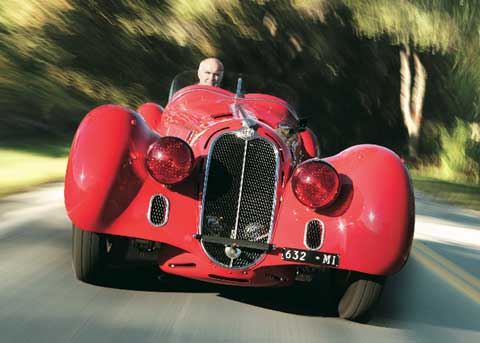
The Greatest Stories Ever Told
By Pete Vack
The Immortal 2.9
Price: $295
Pages: 480, with 500 b&w and color photos
Dimensions: 10.5″ x 10.5″
Order here
A question: Which member of the Romanian royalty purchased a Touring bodied 2.9 in the early years of World War II? Was it Carol, the King himself, brother Nicolas “who drove a Duesenburg at Le Mans,” or the exuberant young son, Michael? For forty years arguments reigned among the historians. In 2007, when the intrepid (never was the adjective so fitting) Simon Moore was finally able to turn his full attention to the matter, he thought “enough of this,” used his many contacts to obtain King Michael of Romania’s email address, and asked the exiled 86 year-old King himself. The resulting story of the Alfa Romeo 2.9 made for a king, restored by a mechanic and confiscated by the communists just as the evil empire fell is one of Moore’s finest chapters.
Kings and Queens bother him not; Moore is going to get to the bottom of the subject come hell or high water. With what must be considerable charm as well as chutzpa, Moore has been able to part people from their irreplaceable photos, from letters written by fathers and mothers, grandfathers and uncles, friends and lovers, and asked them to talk and write about events which occurred as long as seventy years ago. In contrast to the visceral, totally mechanical essence of the Alfa 2.9, Moore mixes the vital human element into the history of oil, gas and aluminum castings, making a wonderful and enjoyable brew.
Alas, his chapters on each one of the cars by serial number are chatty, stitched together, in need of editing. They are often endearing, sometimes annoying but at all times tell a rich, human story centered around one of the great mechanical devices ever made. His writing, even after all these years, still bursts with boyish enthusiasm. His complex explanations are often convoluted and read like Jack Kerouac. But in the end, we loved every word of it. (Read interview with Simon Moore.)
Pre World War II cars like Bugattis, Mercedes and Alfas can possess great historical baggage. It is surely one of the reasons that make the 2.9s particularly desirable. Almost every one has a truly interesting history, a life that reads like a great novel rather than just the brief of a means of transportation. Here are just three examples of some of the greatest stories ever told–
412007 Belle of the RAF Bombers
Moore’s own Alfa. At birth there is mystery, but it was probably first constructed in 1936 as a Scuderia Ferrari cycle fendered car and raced in Europe. It was rebodied by the factory into one of the most beautiful spiders ever to grace a chassis, with red fenders accenting a creamy white body and a white leather interior, ready for the Milan Auto Show of 1936. Exported to England, it was sold to a “charming, charismatic rogue” by the name of Major A.H. Bowden, who filmed the Alfa in color and drove to Monte Carlo in those last happy days before the war began. RAF pilot Tony Crook (later of Bristol Car Company) bought it after he returned from flying for the RAF in Egypt in 1942. It was of the center of attention at his bomber base in Lincolnshire where the pilots admired the Alfa’s lines between their air battles with the Luftwaffe.
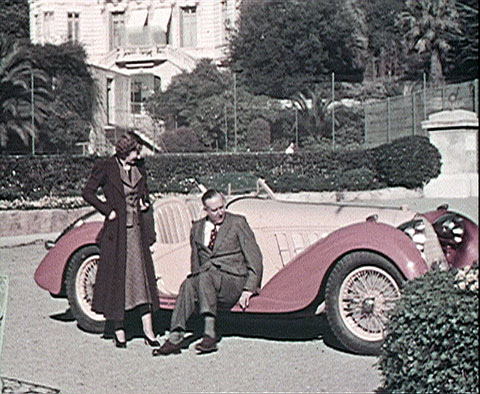
To find color film of your own car circa 1938 must be a thrill. This photo, from a home movie, shows Moore’s own Alfa 2.9 in Monte Carlo with the first owner, Major A.H. Bowden. Photo courtesy Simon Moore.
After the war 412007 left for California to became part of the collection of the fabled and mysterious millionaire Tommy Lee (Moore also devotes an entire chapter to Lee). In the 1950s, it disintegrated into parts to feed California’s postwar backyard sports car building boom. The engine was in one place, the chassis somewhere else, covered by a Glasspar fiberglass body. Ironically, in yet another California locale, the gorgeous Alfa spider body was placed on a mundane Ford sedan chassis. The rolling chassis was rescued in 1980 by Moore. Piece by piece, the car came together after a long and frustrating search for the body with the occasional help of VeloceToday columnist Larry Crane.
412021 Nazis, Wessells and the Buried Treasure
As the first edition of the 2.9 book went to press in 1986, the American Alfa enthusiast Henry Wessells was on the case of a buried 2.9, but the story did not completely unfold until after the book was published. Moore includes Wessells’ amazing tale of the burned and buried Alfa 2.9, along with the Ferrari 250 Testa Rossa, S/N 0720. It is one of the great barn stories of all time. After a sojourn in Italy and Genoa, 412021 turned up in Germany, where according to legend, an Alfa 2.9 with a uniquely styled Touring body was sold to a Nazi “whose name in those days was only uttered with dread.” During the war, the car was taken apart and hidden in Berlin by ex-motorcycle racer Helmet Ryll. When the Russians came to scavenge anything they could, Ryll talked them into taking a more practical bicycle. Ryll was later murdered, and the Alfa somehow made its way to the U.S., some say brought by an American film star. VeloceToday contributor Patricia Yongue and Walter Bäumer, author of the “Maserati 300S,†are still trying to help Moore track down the mysterious Nazi, but Baumer thinks it was the notorious SS officer Dr. Phillip Bouhler. The American film star has yet to be determined.
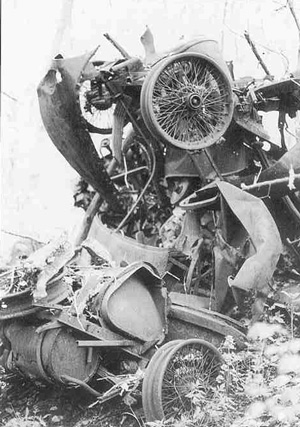
The Biggs 2.9, the most frightening ‘as found’
photo we’ve ever seen. Courtesy of the late
Henry Wessells.
By the 1950s, 412021 became the property of David Biggs, of Clarksville, Missouri. Biggs also owned a Ferrari Testa Rossa and several other classics which shared a space in a large barn. In 1964 lighting struck the barn, started a fire, and the owner could do nothing but watch most of the collection go up in flames. According to some, everything was totally destroyed and nothing was worth saving. The remains were bulldozed into a ravine. But in 1987, Wessells went out again to look at the property, and the first thing he spotted was an Alfa 2.9 chassis, rusty, burned, but salvageable. Then he went after the Ferrari frame. Moore and Wessells relate the fascinating story of the uncovering, and eventual fate of the Biggs 2.9.
412039 Kings, Communists and Crioturo
The case of the aforementioned King Michael of Romania and a poor but enthusiastic Bucharest mechanic is one of the most poignant. As Moore discovered, it was the then-Prince Michael of Romania who ordered the Touring bodied 2.9 in 1942 directly from the factory, made to his specifications. The war ended, the communists took over, and the royal family went into exile. The 2.9 was sold and passed through a number of owners until, in 1966, a mechanic by the name of Ion Croitoru bought the car and lovingly kept the Prince’s Alfa (now equipped with an Alfa 6C2300 engine) in good shape. It took a year for Croitoru and his son to get it back on the road, but eventually they succeeded and used the car for many years. No one cared as the car was not thought valuable.
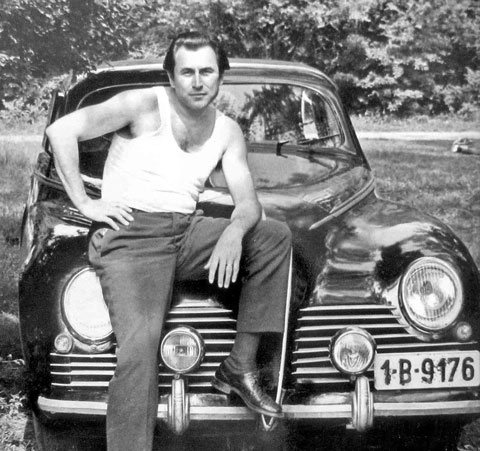
A young Ion Croituro proudly poses in front of his Touring bodied 2.9. The year is 1968, just outside of Bucharest. He bought the car, refurbished it, and drove it for many years. In 1990, the car was taken from him by the Romanian Communists just before the fall of the government. The car, 412039, was ordered new by Prince Michael in 1942. Photo Ion Croituro via Jean Christoph Brial.
In the late 1980s, however, Croitoru was approached by two Communist government officials about the car. First they claimed that the car was now a national treasure and could not be sold, but they returned later and demanded that he sell the car to them anyway! Despite the fall of the Soviet empire, the government officials put pressure on Croituro to sell, to the degree he feared for his life. Just as the revolution was beginning, marking the fall of the dreaded Ceaucescu regime, Croituro was forced give up the car and it was taken away. He was never compensated and still lives in relative poverty. The somewhat unattractive 2.9 made its way to the West, where instead of gaining a much deserved full restoration, the ungainly Touring coupe was removed and a spider body created to replace it.
In addition to the stories of each one of the 2.9s, there are chapters detailing the 1936-38 racing seasons, the technical descriptions, appendixes, index and bibliography. There is so much more one could say and write. But that would be wrong. This is a book that must be bought and enjoyed at leisure, as well as used for a reference work. The Immortal 2.9 ranks as one of the greatest motor books ever published, a fitting monument to the subject, a necessary accessory to the car itself, and for the rest of us, a work of amazing research, concentration, and achievement.
For the first edition in 1986, Malcolm Harris and Moore came up with the format for the 2.9, creating a book with a chapter on each car by serial number. “It was the first significant automobile book organized around the theme of telling the history of individual cars,” wrote Harris. It won the Cugnot Award that year, and the first run of books sold out quickly. Harris failed to tell the printer to save the film from which the book was printed, so no second edition was possible. It took another 22 years to publish another edition, which Harris rightly claims is not just a second but basically an entirely new book, with twice as much text and twice as many photos, and now includes chapters on the S10 and V12 prototypes.
So, to make it clear, this is not a second edition, but a completely revised and much more substantial book. Until the publication of the revised edition, and perhaps even after, first edition copies of The Immortal 2.9 were changing hands at around $1500. To get one now,”revised edition”, which is bigger, better, and basically an entirely new book, will cost only $295.
Below, more photos from “The Immortal 2.9.”
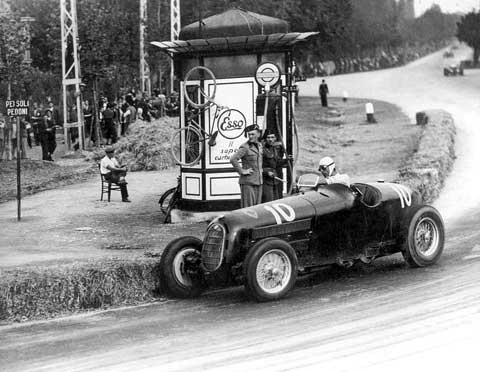
Stunning photos from The Immortal 2.9. Here is Carlo Pintacuda rounding a turn near an Esso gas pump station during a race in 1936 at Modena. This is a stripped down “botticella” 2.9. Photo courtesy Iacona and Bertschi.
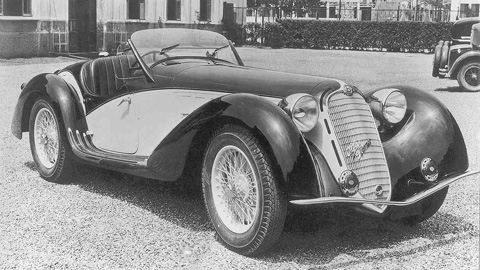
The early 2.9s were rebodied “botticellas†and were in-house Alfa products, not from Touring, but the designs are similar. This car was later rebodied by Martin, then with a recreation Touring body, and lastly rebodied again as a “botticella” (cask, or bottle shape). Simon Moore Collection.
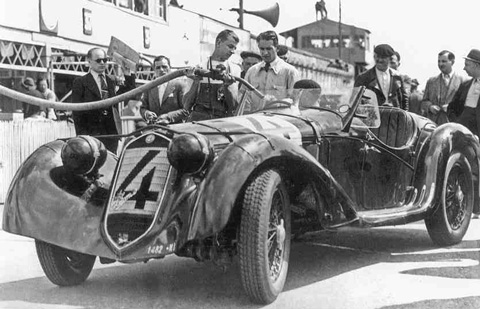
Gianbattista Guidotti drove 412013 from Milan to Le Mans in 1937 as the official Alfa entry. Raymond Sommer was fighting for first place with the Bugatti T57 “Tank†when he over-revved it and blew the engine. The bodywork is by Alfa Romeo. Photo courtesy Alfa Romeo.
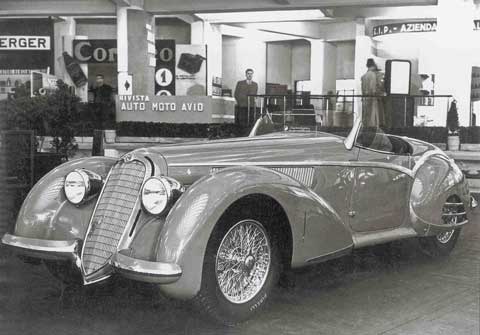
An American by the name of McClure Halley had this Touring bodied spider, 412014, built specifically for him in 1937. It is shown here at the Milan Auto show of that year. Halley did not sell the car until 1952-53. Now part of the John Mozart collection. Photo courtesy Simon Moore collection.
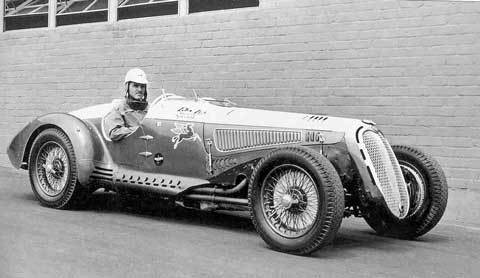
A remarkable photo of the ex-Phil Hill 2.9, 412030. The driver is Mack Hellings, taken just prior to the Pikes Peak event in 1949, while still owned by Tommy Lee, and it looks like it’s ready for the Brickyard. It passed to Hill, then to Brook Stevens, Bill Serri and today is in the Ralph Lauren collection. Photo courtesy Art Stump.
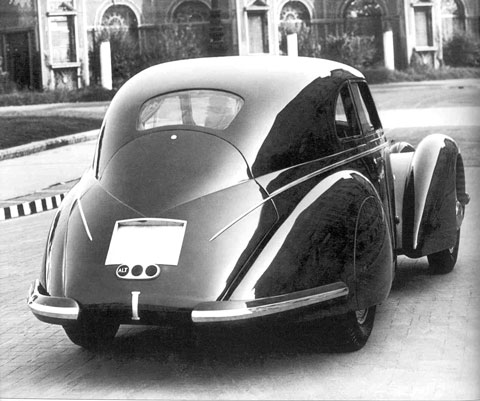
The 2.9 berlinettas were, to a one, beautiful examples of the art, as exemplified by the rear view of the first of the coupes, 412020. After a very rough life in the U.S., it was properly restored in the late 1990s. Photo courtesy Alfa Romeo.
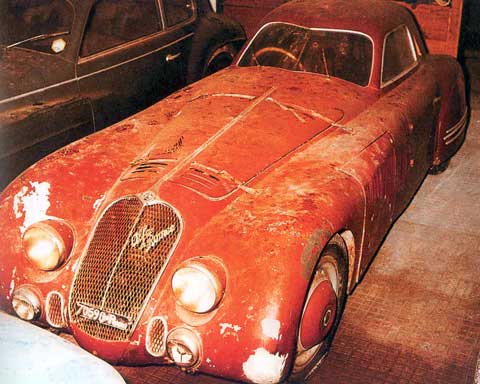
Another all time great barn find. This is the “as found” photo of the 1938 Le Mans Touring 2.9. First bodied as one of the Mille Miglia cars, it was rebodied as a coupe for Le Mans. It was leading the race by 100 miles when a tire gave out, then the transmission. Corrado Cupellini and Giovanni Lurani found the car virtually intact in 1968, as this photo indicates. Photo courtesy Corrado Cuppellini.
This is a fantastic story about wonderful cars.
I wish I had a spare $295.
Thank you.
Don Sawhill
I was lucky enough to pick up a fine edition of The Immortal 2.9 (251 pages) printed in 1986 from Amazon back in 2005 for about $80. It is so fresh, the binding still crackles.
What a wonderful book!
Fantastic!..I shall be buying two Euro-Lottery tickets this week-end!.
What wonderful stories! And as a proud owner of Moore’s 3 volume “The Legendary 2.3” I might just have to pop for this one too. Thanks for the fabulous preview!
Thanks for the great Alfa stories and pictures. I own a 1957 Giulietta Spider in almost new condition after 50 yers and had a great joy driving it for more than 50 years. Una bella machina.
The ancient Alfisti
As a Romanian alfista,it’s fantastic to hear that King Mihai himself owned a 2.9 Alfa.
This is something that stirred my curiosity,it’s a great subject to dwelve into now !
It’s interesting to see another reference to a connection between Tommy Lee and Glasspar. It seems there were several, another being a Glasspar bodied car Lee was putting together for the Carrera Panamericana. But the most interesting was a story Bill Tritt (who was the car side of Glasspar) told me years ago about (and I think it was Tommy Lee) a project to build a v-12 or v-16 engined car with a 6 speed progressive trans, and a fiberglass monocoque body/chassis (which was to be Bill Tritt’s job) to race at Indianapolis. In any case Bill was supposed to meet Tommy Lee at Tommy homee (grand, yes) and Bill waited there for hours and Tommy never arrived. Never arrived there or anywhere else, sad to say.
No Italian or French car connection other than the obvious inspiration of Piero Dusio and Cisitalia for the project. Equally mis-guided and overly ambitious. But either guy, at that time and with their backrounds, could be excused for making such mis-judgement of what would be required. Leaving the field open for the realists.
doug c